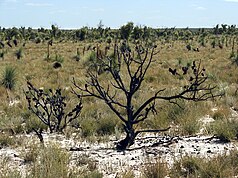Little Desert National Park
| Little Desert National Park | ||
|---|---|---|
| Typical arid savannah landscape in the center of the Little Desert | ||
|
|
||
| Location: | Victoria , Australia | |
| Specialty: | Endangered plants, wildflowers | |
| Next city: | Horsham | |
| Surface: | 1320 km² | |
| Founding: | 1968 | |
The Little Desert National Park (English Little Desert National Park ) is located in the Australian state of Victoria about 375 km west of Melbourne . Today it has a total size of 1,320 km². Due to its nature, the Little Desert, regardless of its name, cannot be classified as a real desert .
This national park was established in 1968 with an area of only 9.45 km² in the Little Desert. The aim is to protect the Mallee eucalyptus vegetation that occurs there and is preserved in its original form . This area is also rich in wild flowers and a refuge for some endangered species.
This came after the state government of Victoria announced that it intended to sell 800 km² of the surrounding and unused desert area for agricultural purposes. Local resistance to this sales plan was strong and quickly gained national support. The state government remained unmoved by these protests, but was ultimately convinced by the inefficiency of the project. Although the small desert has as much annual precipitation as the surrounding agricultural areas, it consists of deep, sandy soil that is much more difficult to store water. This area was therefore of poor use for agriculture , and there was no prospect of acceptable sales prices. One was convinced that the small desert in its originality was of higher value. In December 1969, 353 km² was added to the national park. As a result, the park area grew to its present size by 1988 .
The Little Desert National Park is divided into three areas, a western, a central and an eastern area. The annual rainfall is between 400 mm in the northeast and 600 mm in the southwest. The desert consists of very different soil formations in the individual areas, which have made different types of vegetation zones possible. About 670 different plant species live here, which make up about a fifth of Victoria's biodiversity . In addition, over 220 different species of birds can be found in this area, including the thermometer chicken with its remarkable breeding method, various types of wrens , currawongs and honey-eaters . The park is also home to fox cusus , short-headed gliding pouches and bearded dragons .
The best time to visit the national park is between August and October, when the flora is in full bloom.
Web links
Individual evidence
- ↑ a b c d Australian Government - CAPAD 2014 - VIC summary ( MS Excel ; 376 kB), DSEWPaC , accessed on March 23, 2016 (English)
- ↑ a b Parks Victoria - Culture and Heritage , accessed on March 23, 2016 (English)
- ↑ Parks Victoria - Environment , accessed on March 23, 2016 (English)


